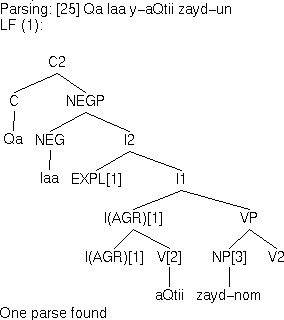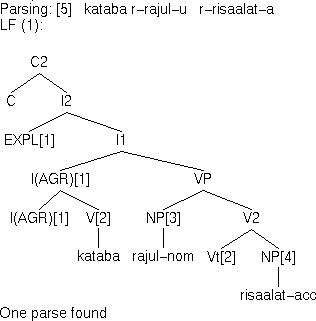
[5] kataba r-rajul-u r-risaalat-a
wrote the-man-nom the-letter-acc
The man wrote the letter
[6] Qarad-tu Qan y-uqaabil-a r-rajul-u l-mudiir-a
wanted-I that 3-meet-subj the-man-nom the-director-acc
I wanted the man to meet the director
[25] Qa laa y-aQtii zayd-un
Q not 3-comes Zayd-nom
Isn't Zayd coming?
[Notes: orthographical representation limited by ASCII. Q for ?
(glottal plosive). Capitalization in general will indicate the
presence of unrepresented diacritics.]
Need the following components:
EXPL (new)
In PAPPI, markers are elements that don't project syntactic structure, but instead are realizations of features. Sample lexical entries:
% markers lex(ta,mrkr,[left(v,morph(_,past(+)),[]), k(a4bf)]). lex(wa,mrkr,[left(n,[], morphC(topic)),k(a4cf)]). lex(ga,mrkr,[left(n,[], morphC(nom)), k(a4ac)]). lex(o, mrkr,[left(n,[], morphC(acc)), k(a4f2)]). lex(wo,mrkr,[left(n,[], morphC(acc)), k(a4f2)]). % orthography lex(no,mrkr,[left(n,[], morphC(gen)), k(a4ce)]). lex(ni,mrkr,[left(n,[], morphC(dat)), k(a4f2)]).
Lexical entries:
lex(to,mrkr,[right(v, morph(_,[]),inf([]))]). % infinitival marker lex(of,mrkr,[right(np,case(gen), [])]). % object genitive Case
lex(il,pf(cl),[a(-),p(+),agr([3,sg,m])|Fs]) :- subjClFeaturesInv(nom,Fs). subjClFeaturesInv(MCase,[adjoin(v,right),morphC(MCase)]).Assume -tu in Qarad-tu is a pronominal clitic.
X' rule system:
rule XB -> [X|compl(X)] ordered headInitial(X) st bar(XB), proj(X,XB), head(X). rule compl(X) -> [] st lexicalProperty(X,grid(_,Roles),no1stRole(Roles),_). rule compl(X) -> [Y] st compl(X,Y). rule compl(X) -> [Y] st lexicalProperty(X,grid(_,Roles),csr1st(Roles,Y),Y). rule compl(X) -> [Y] st lexicalProperty(X,subcat(Y$_,_),Y).In standard PAPPI, neg is between Infl and V.
compl(i,vp). compl(i,negp). compl(neg,vp). compl(c,i2).

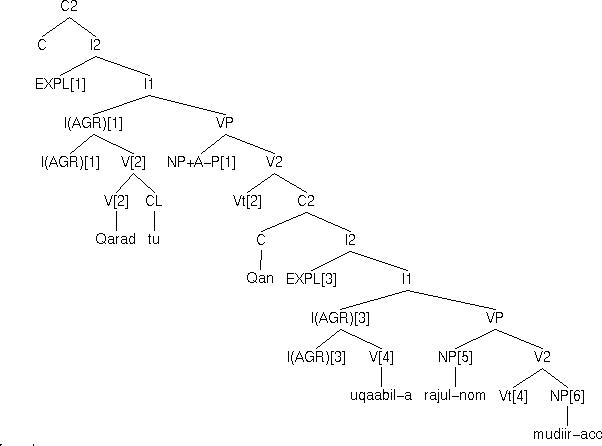
Two parses are reported by PAPPI for (6). Coindexation/non-coindexation of the two expletives.
xbar.pl:
%% HEAD MOVEMENT %% NB. requires rule for empty C for adjunction in periphery rule v(V) moves_to i provided agr(strong), finite(V). rule v(V) moves_to i provided agr(weak), V has_feature aux. rule v(V) moves_to i moves_to c provided agr(strong), finite(V). rule v(V) moves_to i moves_to c provided agr(weak), V has_feature aux, finite(V). rule i(I) moves_to v(V) provided agr(weak), \+ V has_feature aux, post_cond addFeature(noECP(_),I). rule i(I) moves_to v(V) provided agr(strong), \+ finite(V), post_cond addFeature(noECP(_),I). rule v doesnt_move provided v$vp subcat_by v. rule v(V) moves_through neg provided_iff negationMoves, V has_feature neg. rule i(I) derived_from v(V) provided recoverIfromV(I,V). rule neg(Neg) derived_from v(V) provided negFromV(Neg,V). % Coping with antecedent government of head traces rule head_adjoined _ add_feature transparent(ecp).Set language parameter:
agr(strong)Rules are selected and compiled into the bottom-up parser with an environment stack for passing HM traces. For details, see "Verbal Inflection, Head Movement and LR Parsing", Fong S. To appear in Principle-Based Parsing: from Theory to Practice, ed. R.C. Berwick, Kluwer Academic.
lex(there,n,[agr([3,[],[]]),nonarg(+),linkTo(np)]). lex(it, n,[agr([3,sg,n]), nonarg(+),linkTo(c2)]).Crucial feature is
nonarg(+).
linkTo for expletive linking there is a man
in... and it is important that....
Empty categories are inserted essentially as featureless (modulo positional features) at phrase structure recovery time:
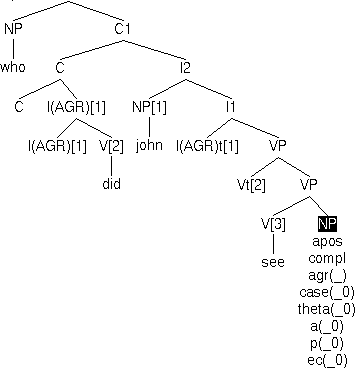
Features instantiated as constraints are applied over the course of the derivation:
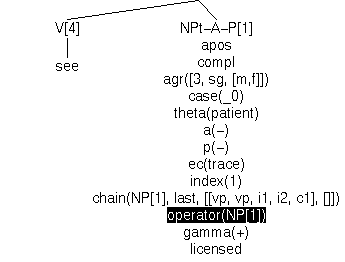
Typology: PRO, pro, wh-trace, NP-trace, parasitic gap, etc.
In particular, in the standard implementation, BT-relevant features
a(_) and p(_) are instantiated by Functional
Determination.
Other principles: ECP, AGR Criterion (see AGR Criterion notes)
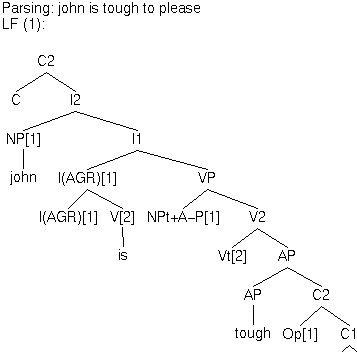
Structural Case assignment occurs under government. Extend definition of government to allow INFL to govern into Spec-VP (bit like ECM):
governs(I,Subj,Proj) :- % governing into Spec-VP \+ adjoined(Proj), I head_of Proj, I has_feature agr(AGR), poorAGR(AGR), XP complement_of Proj, Subj specifier_of XP.In the following tree,
Proj = I1/I2, I = I(AGR)[1], XP = VP,
Subj = NP[3]:
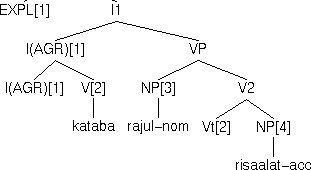
[For poorAGR/1, see AGR Criterion notes.]
% Case lex(u, mrkr,[left(n,[],[suffix(nom),morphC(nom)])]). lex(un,mrkr,[left(n,[],[suffix(nom),morphC(nom)])]). lex(a, mrkr,[left(n,[],[suffix(acc),morphC(acc)])]). lex(an,mrkr,[left(n,[],[suffix(acc),morphC(acc)])]).
left(C,MatchFeatures,NewFeatures)
| Parameter | Description |
|---|---|
C
|
category to which the marker attaches |
MatchFeatures
|
list of features the matching category must have |
NewFeatures
|
the features represented by the marker |
morphC(nom/acc) is added to the noun to which the marker
(mrkr) attaches.
[suffix/1 is for tree display purposes only.]
Example:
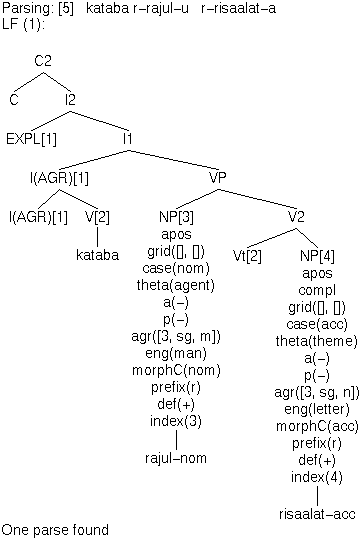
right/3:
lex(r,mrkr,[right(n,[],[prefix(r),def(+)])]).for r-raju-u and r-risaalat-a in (5).
[prefix/1 is for tree display purposes only. Doesn't work
at the moment.]
Verb agreement morphemes are also implemented this way. For example:
% Agreement
lex(at,mrkr,[left(v,[],[suffix(f), agr([[],[],f])])]). % f
lex(na,mrkr,[left(v,[],[suffix('f.pl'),agr([[],pl,f])])]). % f.pl
at encodes GEN (f) and na encodes GEN + NUM for
daxal-at (entered-f) and daxal-na (entered-f.pl),
respectively.
What to do about Qayy-a rajul-in (which-acc man-gen) and kull-a rajul-in (every-acc man-gen)?
[39a] baqarat-an Saahad-tu
cow-acc saw-I
A cow, I saw

Also see parse for (6).
lex(tu,pf(cl),[a(-),p(+),agr([1,sg,[m,f]]),eng(i)|Fs]) :- subjClFeatures(Fs). subjClFeatures([adjoin(v,right),morphC(nom)]).
[25] Qa laa y-aQtii zayd-un
Q not 3-comes Zayd-nom
Isn't Zayd coming?
Redefine compl/2 relation:
compl(i,vp). compl(neg,i2). compl(c,i2). compl(c,negp).
